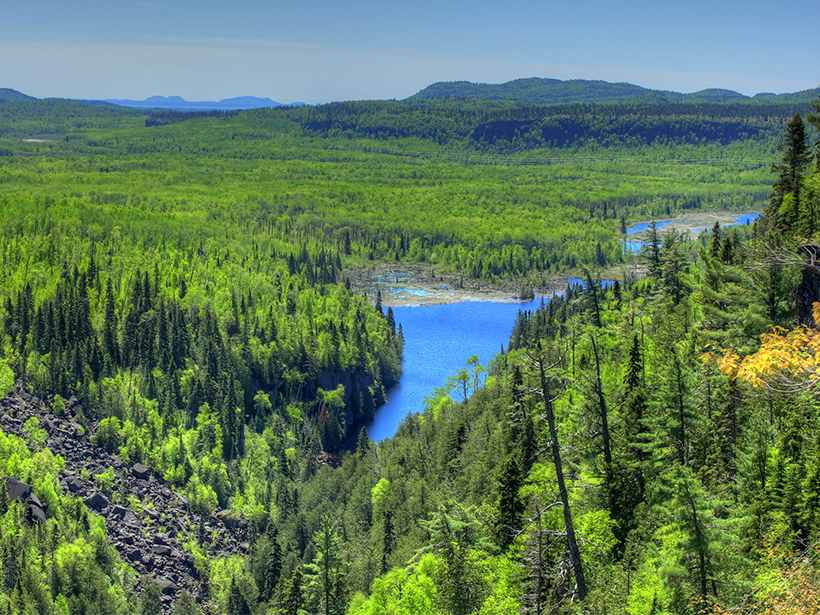Source: Journal of Geophysical Research: Biogeosciences
What comes to mind if you’re asked to think of the natural landscapes of Canada? Chances are you will picture forest, endless forest. A wilderness landscape of lakes, rivers, and mountains covered in trees, abundant in wildlife but sparsely populated by humans.
This is Canada’s boreal zone, comprising more than half of Canada’s land area and spanning the country from the eastern coast to the Alaskan border in the west and part of a boreal zone circling the Northern Hemisphere.
As one of the largest forest ecosystems on the planet, the boreal forest plays a significant role in the global carbon cycle, simultaneously being a “sink,” “stock,” and “source” of carbon. As sinks, forests absorb carbon by converting carbon dioxide from the atmosphere into organic material. As stocks, forests store carbon over long periods of time, for example, in deep organic soils, peatlands, and permafrost. As sources, forests release carbon, for example, through wildfires, organic matter decomposition, or melting permafrost. The relationship between these factors creates the “carbon balance.”
Accurate calculations of carbon sinks, sources, and stocks are needed to understand how forests will respond to climate change and alter the carbon cycle. Although models have become increasingly sophisticated, there are many variables to consider and thus a lot of uncertainties, including regional and local diversity, to account for.
Boreal forests are expected to feel the effects of climate change proportionally more than other regions because higher latitudes are projected to warm more than lower latitudes. With this concern, boreal ecosystems have been widely studied, but Gonsamo et al. found a gap, the unmanaged forests of the Far North of Ontario (FNO) in Canada.
Focusing on a forested area of more than 170,000 square kilometers, mostly in the southern and southwestern parts of FNO, the researchers sought to build a picture of the area’s carbon balance in the past, present, and future. They specifically focused on responses to changes in atmospheric carbon dioxide, climate, forest age structure, disturbance by forest fire, and nitrogen deposition.
The team used the Integrated Terrestrial Ecosystem Carbon Cycle model to understand the carbon dynamics of this type of forest. The model uses data on soil texture, drainage, land cover, leaf area index, and forest stand age. The authors projected changes in carbon stocks of soil, vegetation, and soil and vegetation combined for 10 simulation scenarios.
Their simulations of the past (1901–2004) showed stable vegetation carbon stock and declining soil carbon stock, the overall net effect being a decrease in total carbon stored in the region. This was predominantly linked to a steady increase in mean air temperature over the period, causing increased soil carbon release through organic matter decomposition.
Their simulations of the future (2007–2100) suggested that climate warming and increased carbon dioxide in the atmosphere would stimulate vegetation growth and thus increase the amount of carbon stored in vegetation and that this would outweigh the amount of carbon released from soil and fire disturbance, both caused by climate change. A strong tree growth response to elevated carbon dioxide—an issue of scientific debate—is required for the forests to be a carbon sink.
This study presents new insights into one of the least studied ecosystems in Canada but one that is expected to be significantly affected by climate change. What’s important is that it challenges previous assumptions that these forests would likely shift from being net sinks to net sources of carbon. The authors stress that this remote wilderness is poised to have a pivotal influence on the planet’s future and that further research is needed in this area. (Journal of Geophysical Research: Biogeosciences, https://doi.org/10.1002/2016JG003627, 2017)
—Jenny Lunn, Contributing Writer
Citation:
Lunn, J. (2017), The future hangs in the (carbon) balance, Eos, 98, https://doi.org/10.1029/2017EO078477. Published on 08 August 2017.
Text © 2017. The authors. CC BY-NC-ND 3.0
Except where otherwise noted, images are subject to copyright. Any reuse without express permission from the copyright owner is prohibited.

